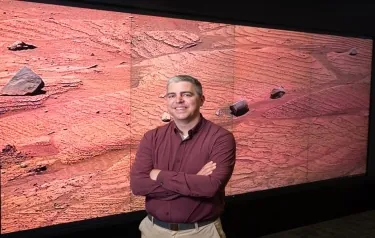
Martian Mysteries: Curiosity Rover Unveils Evidence of Carbon Cycle on the Red Planet
2025-04-23
Author: Noah
NASA's Exciting Discovery on Mars
NASA has taken a significant leap toward unraveling the potential for life on Mars with groundbreaking discoveries made by the Curiosity rover.
Ancient Carbon Deposits Discovered
Recent research reveals that Curiosity has uncovered large carbon deposits, indicating a possible carbon cycle on ancient Mars. This exciting revelation sheds light on the planet's ability to support life in the past.
Exploring Gale Crater's Secrets
While exploring the Gale Crater, the Curiosity team is delving into the climate transitions and habitability of ancient Mars. A new paper published in the journal *Science* details findings from three drill sites where the rover found siderite, an iron carbonate, nestled within sulfate-rich layers of Mount Sharp.
Dr. Ben Tutolo from the University of Calgary, who contributed to this research, expressed that these findings challenge previous notions and are crucial for understanding Mars' geological and atmospheric evolution.
Mars’ Dramatic Transformation
The presence of highly soluble salts in these rocks suggests that Mars experienced a significant transition from a warm, wet world to its cold, arid state. Carbonates were predicted to form in the early Martian atmosphere rich in CO2, but such evidence had previously been elusive.
Supporting Liquid Water on Mars?
The discovery of carbonates implies that Mars' atmosphere once contained sufficient carbon dioxide to allow for the existence of liquid water on its surface. As the planet's atmosphere began to thin, this carbon dioxide transformed into rock.
Future Missions to Unravel More Secrets
NASA is poised for future missions that may confirm these findings and uncover more about Mars' enigmatic early history and atmospheric loss. As Tutolo explains, this research nudges scientists closer to understanding whether Mars ever had the right conditions for life.
Implications for Habitability
The implications are profound: Mars was indeed habitable at one point, challenging existing models of habitability. However, as CO2 precipitated as siderite, it likely hindered the planet's ability to maintain warmth.
Learning from Mars for Earth’s Future
Dr. Tutolo's ongoing research at home uses these Martian mechanisms to inform efforts to convert anthropogenic CO2 into carbonates to combat climate change. He emphasizes that understanding Mars' transformation reveals the delicate balance required for sustaining life.
The stark contrasts between Earth and Mars serve as a crucial reminder of our planet’s resilience over billions of years, highlighting the fragile nature of habitability elsewhere in the universe.
What Went Wrong for Mars?
What remains crucial is deducing how much CO2 from Mars' atmosphere was sequestered and whether this contributed to the planet's loss of habitability. This exploration not only enriches our understanding of Mars but also underscores the precarious balance of conditions that support life.









 Brasil (PT)
Brasil (PT)
 Canada (EN)
Canada (EN)
 Chile (ES)
Chile (ES)
 Česko (CS)
Česko (CS)
 대한민국 (KO)
대한민국 (KO)
 España (ES)
España (ES)
 France (FR)
France (FR)
 Hong Kong (EN)
Hong Kong (EN)
 Italia (IT)
Italia (IT)
 日本 (JA)
日本 (JA)
 Magyarország (HU)
Magyarország (HU)
 Norge (NO)
Norge (NO)
 Polska (PL)
Polska (PL)
 Schweiz (DE)
Schweiz (DE)
 Singapore (EN)
Singapore (EN)
 Sverige (SV)
Sverige (SV)
 Suomi (FI)
Suomi (FI)
 Türkiye (TR)
Türkiye (TR)
 الإمارات العربية المتحدة (AR)
الإمارات العربية المتحدة (AR)